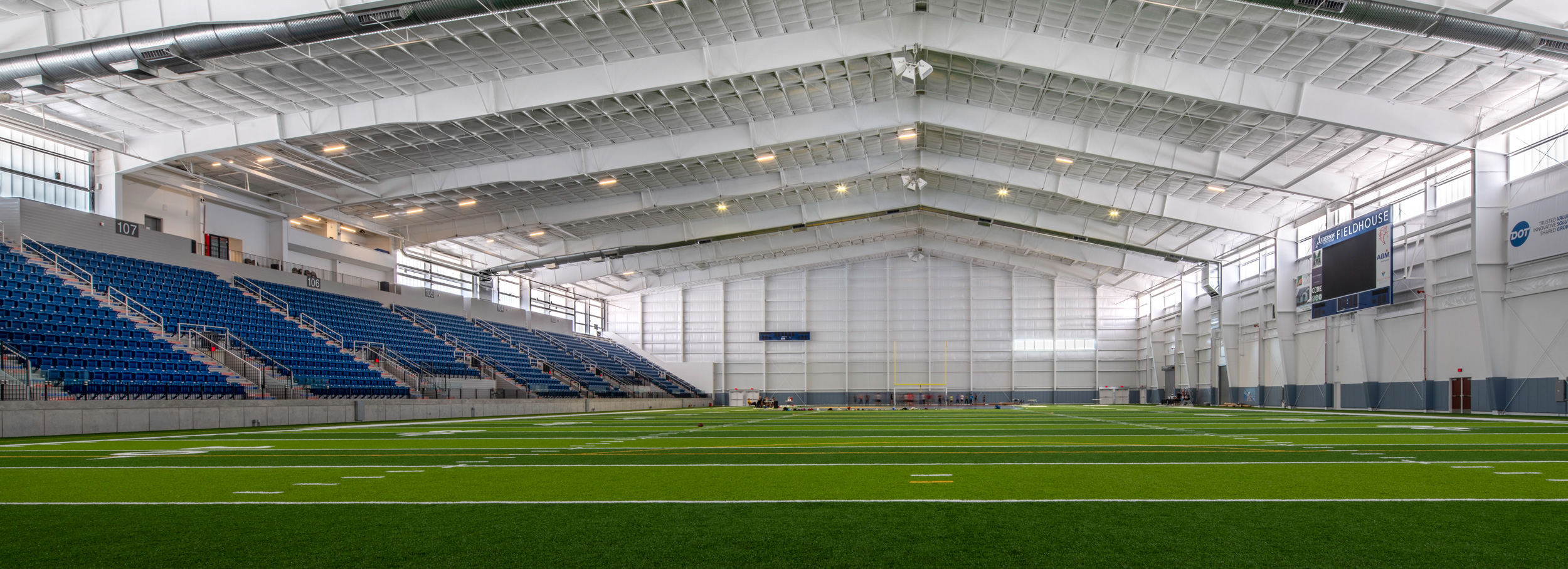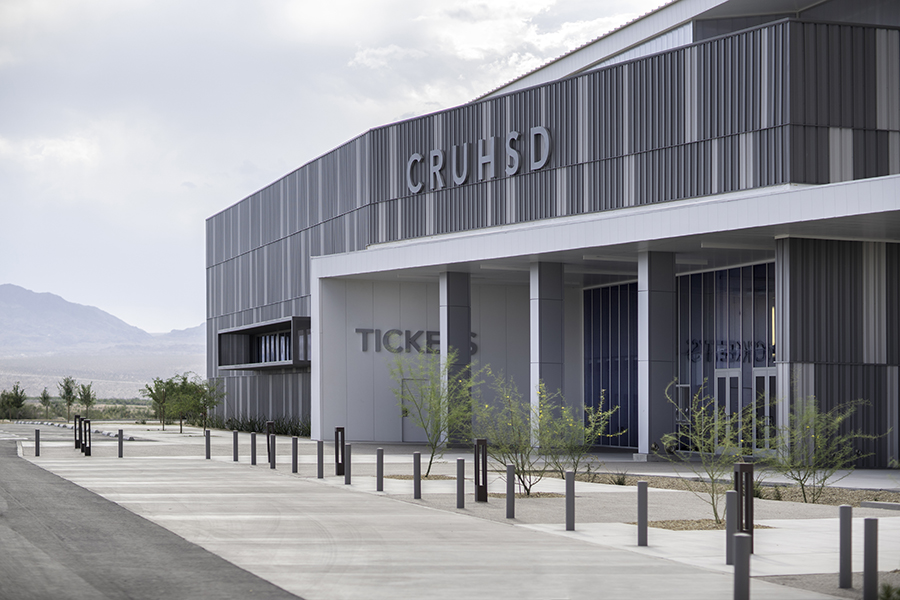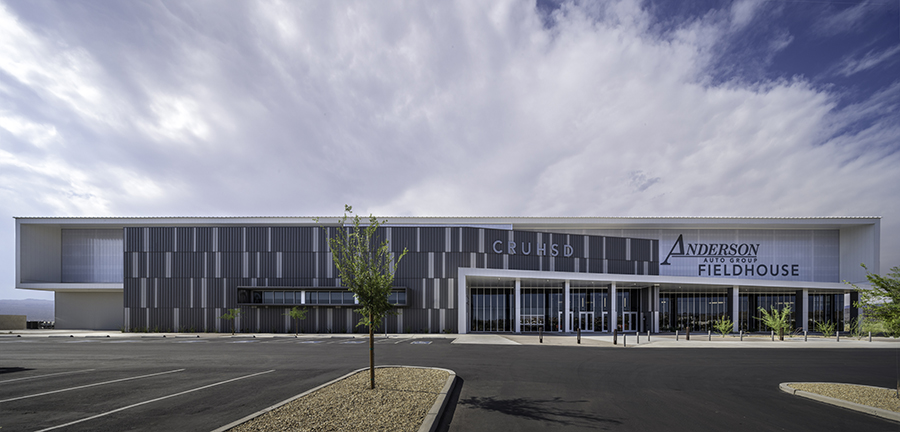February 15, 2021

Explore the Anderson Auto Field House, a 122,500 square foot sporting events facility located in Bullhead City, Arizona, USA.
Orcutt | Winslow, an Archicad firm based in Arizona completed construction of the Anderson Auto Field House in April of 2019. The 122,500 square foot sporting events facility serves as an indoor sports arena for the Colorado River Union High School District (CRUHSD) which consists of two high schools in this extremely hot part of Arizona known as Bullhead City.
The location’s low elevation brings with it hot, windy, and arid conditions, making an indoor facility desirable for the schools’ athletics programs.
Those environmental aspects factored into the design of the facility as well. Metal panel cladding with irregular textures evoke the stratification visible in the nearby mountains – where erosive forces of wind have left their marks over time.
Matt Johnson, associate at Orcutt | Winslow and architect on the project explains, “This was a really interesting project from a size and use perspective. The building is pre-engineered metal structure with a span of about 260 feet, creating a full, clear span across the bleachers and the field area eliminating columns that might otherwise block any spectator views.”

The building is pre-engineered metal structure with a span of about 260 feet, creating a full, clear span across the bleachers and the field area eliminating columns that might otherwise block any spectator views.
Matt Johnson, associate at Orcutt | Winslow
The venue boasts a mixed seating capacity of 4,500. Portable flooring allows for the transformation of its turf field into a hard floor, for other sports to be played there indoors or to use the fields for concerts, graduation ceremonies and the like.
Looking back on how the project came to be, Johnson reflects on some of the initial obstacles that the firm overcame – not the least of which was overcoming some site negotiation-inflicted delays which compressed the design process significantly.
“After being awarded the project in late 2018 the real work began in January 2019 – but it took until June of that year to secure a site. The grand opening date had not changed however, so we lost six months of design and coordination time during our site test efforts. We had a general floor plan for the building, but we still needed a design and we still had a lot of coordination to do with the pre-engineered company.”

Rising to the Coordination Challenges of Pre-Engineered Building
Coordinating a pre-engineered building takes time. Performing that coordination while designing was a challenging process. Yet Johnson says, their modeling team of two, empowered by Archicad made it possible to execute.
When you consider the complexity of the project, the fact that we were able to get this done with such a small team is incredible.
“The obstacle was time and in this particular case having a really amazing BIM tool is what helped us to overcome it. The back-and-forth with the pre-engineered building took a few months all by itself and had to be complete before we could submit to the city. It also required the structural engineers from the pre-engineering building company and the architectural design team to work together and share calculations. When you consider the complexity of the project, the fact that we were able to get this done with such a small team is incredible.”
To meet budget and schedule constraints, the team at Orcutt | Winslow took a practical approach and chose to use a pre-engineered metal building known for their fast construction and affordability. Getting the design where they wanted it presented yet another challenge the team at Orcutt | Winslow was determined to overcome.
“We knew the pre-engineered metal building approach was our best bet – but we wanted the project to feel special and make it so that people wouldn’t even realize that it was a pre-engineered building.”
During the six months of site search, Orcutt | Winslow worked with the contractor to learn how to best use the pre-engineered building system to their advantage.
“We learned that they could attach a 12-foot cantilever off their frames, which are tapered from two to four feet deep and take all of the vertical load. That allowed us to use translucent wall panel along the upper 30 feet of the south elevation of the building. We knew would provide adequate shade and prevent direct sunlight, while allowing for massive natural daylighting, aesthetically, the translucent wall panels change the feel almost singlehandedly.”
With an aim to make the concession and main concourse area feel inviting, the design called for the use of glass. The 18-foot floor to ceiling span of glass storefront and the polycarbonate wall panels above, elevates the character of the building from the outside.
“It brought so much light into the space, which changes the experience being there. Sports arenas can be dark. The concourse in most arenas is missing natural light, so we worked to balance that, especially when you consider this facility is more than a sports arena.”
This choice to bring in natural light, greatly reduces having to rely on costly artificial light. Day games can be mostly lit naturally because of the polycarbonate wall panels, and the deep projections provided by the cantilever protect the polycarbonate wall panels from the hot Arizona sun.

Employing a Full BIM Process
Orcutt | Winslow used as full of a BIM process on this project as possible, getting mechanical models for the building. Archicad empowered IFC protocols to support the firm in getting all the necessary components modeled together, even as a proprietary software came into play.
“We used IFC import files into our model from structural (the foundation), mechanical, and the hybrid stadium seating model from the sub-contractor and pre-engineered company on their proprietary system. Archicad helped incorporate all of those elements to get us to reality.”
Having Archicad manage all the different inputs, Archicad performed smoothly.
“Having everybody’s information in there, the pre-engineered building model, the structural foundation model, the stadium seating model, the architectural model, the mechanical model – helps to eliminate guesswork.”
All this coordination through IFC helped Orcutt | Winslow work with their tight timeline too.
“The day we submitted to the city we already had the shop drawings for the pre-engineered building and for the grandstand seating so we could start doing our internal shop reviews. The importance of Archicad as a powerhouse software that can just take everything on and play nice with the various methods of creating designs and structures and systems cannot be understated.”
Kudos for the Curtain Wall Tool
Another aspect of using Archicad on this project for Orcutt | Winslow lies in the power of the curtain wall tool. Johnson says he considers the feature having two-fold potential to impact efficiency.
“On this project, the curtain wall tool allowed us to significantly reduce time spent on the modeling process. It empowers the rapid multiplication of elements. It also significantly reduces the management of those elements when changes are required later. We are able to rapidly edit entire groups of elements en masse.”
Matt Johnson, associate at Orcutt | Winslow

In situations where a client, hypothetically speaking, decides they want a different size tile. When firms use the curtain wall tool to create that tile, the process of editing it involves changing the module which updates the entire project. Changing tile size without the benefit of the curtain wall tool, when it involves photo textures or with individual slab/morph elements, would be considerably more time consuming.
“When I compared creating a complicated element (a shade screen for example) before we implemented the curtain wall tool into our workflow, there could be hundreds, or thousands of individual parts involved. The display of those elements in “plan” view is tricky, pieces are stacking on top of one another – which makes editing those elements cumbersome. The curtain wall tool, however, treats these types of multi-component structures as self-contained entities that live in a virtual “bubble” which greatly simplifies moving them around and editing them, and that makes us faster.”
The entire envelope of the building was modeled with the curtain wall tool. Johnson says Orcutt | Winslow used it for the metal panels and for the poly carbonate panels. This feature of Archicad let the team use actual dimensions from the product to make sure they lined up as expected and the final product matched the design intent.
The curtain wall tool also assisted in modeling the ceiling grids. Demonstrating the creativity of Johnson and his team, as well as the adaptability of the tool, this instance represented a non-traditional use of the tool.
“We used it to create patterns that would not have been as easy to manage with slab and/or roof elements. The curtain wall tool offered a design flexibility to us – since we employed it as we modeled all the tile in the project, public areas, and restrooms. Being able to easily change the color of the tile and grout to match our desired output without fussing around making photo textures to place on wall surfaces was an important added benefit.”

“Elements could be scheduled and quantified much more easily when using the curtain wall tool than if they were part of a wall. It helped us to model our crash pads around the fields, easily adding the dimensions of the products and then applying huge sections of it without having to model and then manage individual objects. It goes without saying that we used the curtain wall tool to model our curtain walls and storefront windows as well.”
About Orcutt | Winslow
Orcutt | Winslow specializes in the design of people-oriented architecture, planning and interior design services.
For more information visit owp.com